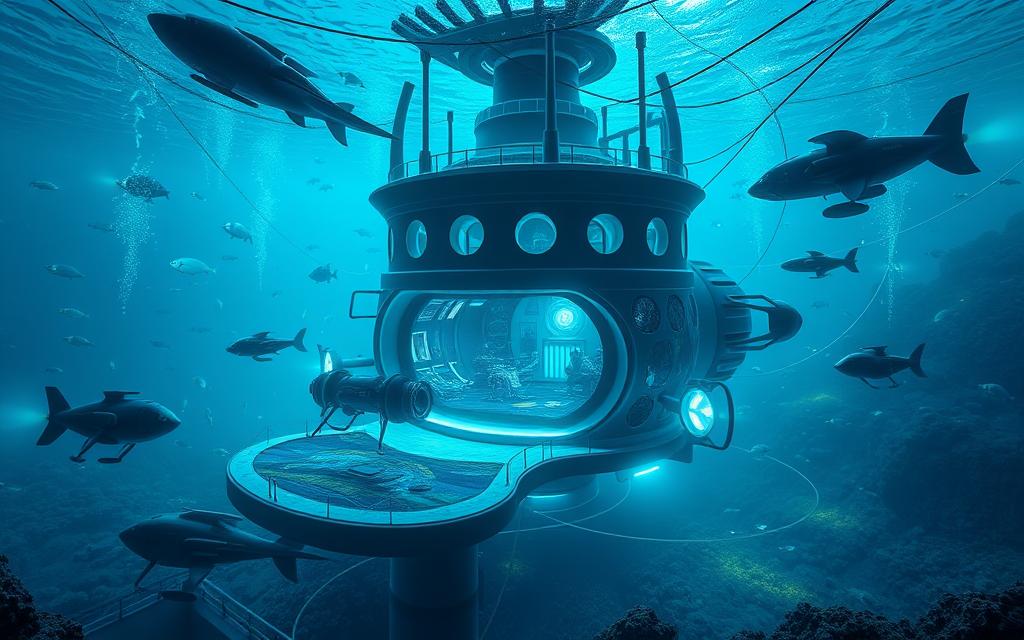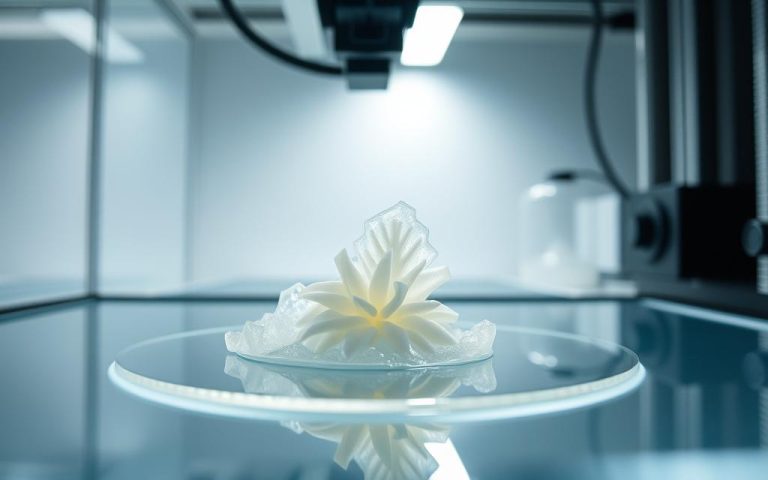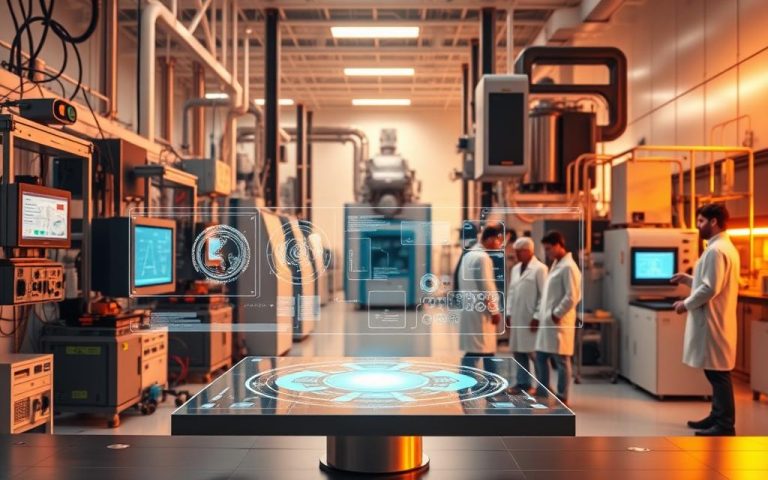Exploring Ocean Technology: Innovations Beneath the Waves
Ocean technology is growing fast, with new innovations changing how we see the sea. The deep ocean is full of secrets and strange creatures. It’s one of the least explored places on Earth. This makes ocean tech and marine innovations key for learning more.
The Monterey Bay Aquarium Research Institute (MBARI) is leading the way. Since 1987, they’ve made many discoveries. They use advanced tools like AUVs and ROVs to study the ocean and its life. This is opening up a new world of ocean tech and marine innovations.
Understanding the ocean is vital. It inspires new tech and helps protect it. As we explore the ocean, we’re also finding ways to keep it healthy. This shows how important ocean tech and underwater exploration are for our future.
What Is Ocean Technology: Understanding the Basics
Ocean technology covers a wide range of marine technology and ocean innovations. It has changed how we see the world’s oceans. Underwater vehicles have been key in learning about marine life.
The need for better ways to explore the ocean drove the growth of ocean technology. Now, marine technology uses many tools. These include satellite remote sensing, acoustic sensors, and underwater vehicles.
Definition and Scope of Marine Technology
Marine technology uses science and engineering to study the ocean. It involves creating new tools, like underwater vehicles. It also means using old technologies in new ways.
Historical Development of Ocean Exploration Tools
The history of exploring the ocean is filled with big steps in ocean innovations and marine technology. Sonar and radar were early tools. Now, we have modern underwater vehicles.
Key Components of Modern Ocean Technology
Today’s ocean technology has many important parts. These include underwater vehicles, sensors, and satellite systems. They help scientists study the ocean in great detail.
Revolutionary Underwater Mapping Systems
Underwater mapping has seen big changes lately. New tech lets us make detailed maps of the ocean floor. Multibeam sonar technology is key, giving us detailed maps of big areas. It’s vital for marine geography and understanding the sea.
New tech, like single-photon array detectors and high-power lasers, will make mapping better. The Revolutionary Underwater Mapping Systems project is a big step. It aims to make a subsea mapping system that works well. This could change how we map the ocean floor, helping with offshore wind farms and environmental checks.
These advanced systems offer many benefits:
- They give us clear images of the ocean floor.
- They can map big areas fast and well.
- They make marine geography more accurate and detailed.
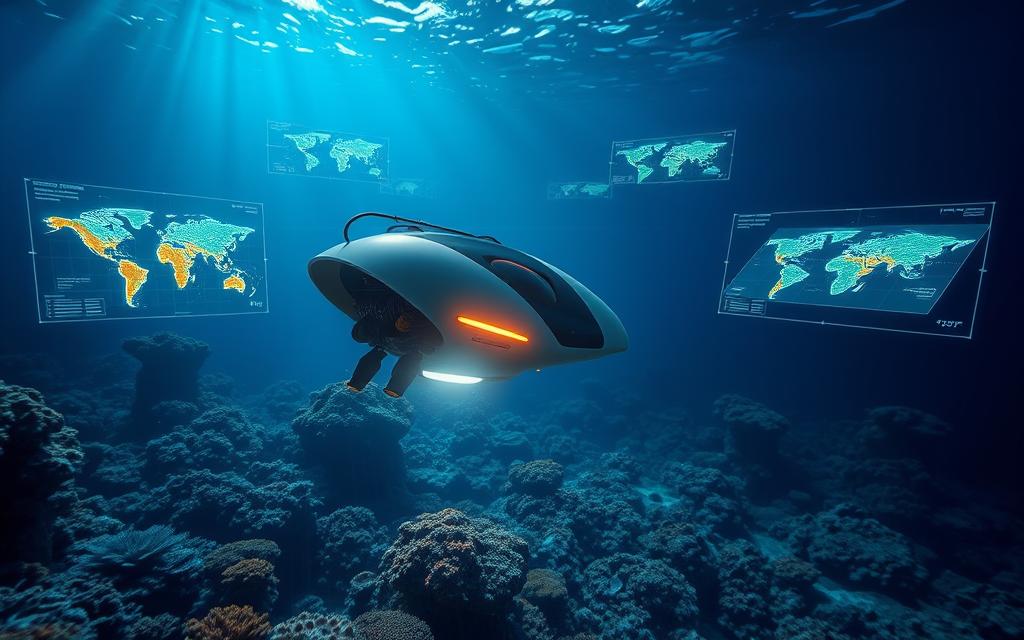
These technologies will greatly help us understand the ocean floor and its life. As we keep improving them, we’ll see big leaps in ocean floor mapping and exploration.
Deep-Sea Exploration Vehicles and Equipment
Exploring the deep sea has become easier thanks to advanced underwater vehicles. These include Autonomous Underwater Vehicles (AUVs) and Remotely Operated Vehicles (ROVs). AUVs have changed the game by making deep-sea research cheaper and more efficient.
ROVs are robotic subs linked to a ship and controlled by experts. They have cameras, lights, sonar, and arms for collecting samples. The ROV Ventana’s launch in 1990 was a big step, allowing scientists to dive deep into Monterey Bay.
Key Features of Underwater Vehicles
- AUVs can use acoustic communication that travels up to 1 kilometer underwater
- ROVs are equipped with video cameras, lights, sonar systems, and manipulator arms
- AUVs are programmed ahead of time to execute missions due to slow underwater communication
These vehicles have greatly helped us understand the deep sea. They’ve made many discoveries possible. With ongoing tech improvements, like better lights and cameras, the future of deep-sea exploration is bright.
| Vehicle Type | Depth Limit | Key Features |
|---|---|---|
| AUVs | Up to 6,000 meters | Acoustic communication, autonomous operation |
| ROVs | Up to 6,000 meters | Video cameras, lights, sonar systems, manipulator arms |
Ocean Monitoring and Data Collection Technologies
Understanding our oceans is key, and ocean monitoring helps a lot. Advanced sensors and tech have changed oceanography. Now, scientists can track ocean currents, temperature, and more accurately. NOAA and Saildrone have teamed up, creating solar-powered vessels to collect ocean data.
These vessels are packed with sensors that give us insights into the ocean. They help manage fisheries, find oil spills, and protect endangered species. They also aid in climate change studies, showing how the ocean absorbs heat from greenhouse gases.
Technologies like satellite remote sensing and AI have improved data analysis. This has led to a deeper understanding of ocean dynamics. It also helps in creating better conservation plans. The ocean’s role in climate regulation makes data collection and sensors in ocean monitoring even more crucial.
Some main uses of ocean monitoring data are:
- Climate change research
- Sustainable fisheries management
- Conservation of threatened species
- Detection of oil spills and other pollutants
Marine Renewable Energy Innovations
The world is moving towards sustainable energy, and marine renewable energy is key. The ocean, covering over 70% of our planet, is full of energy potential. Tidal and wave energy can help make our energy future greener.
In the United States, marine energy could power about 57% of all power generation in 2019. This is huge, especially since over 50% of Americans live near the coast. Technologies like tidal power and wave energy keep our oceans beautiful while powering our homes.
Tidal Power Systems
Tidal energy is very promising. It uses the ocean’s tides, which are always there. For example, tidal energy in Alaska’s Cook Inlet could power the whole state.
This makes tidal power a reliable source of clean energy. It helps us move towards a world with less pollution and more sustainable energy.
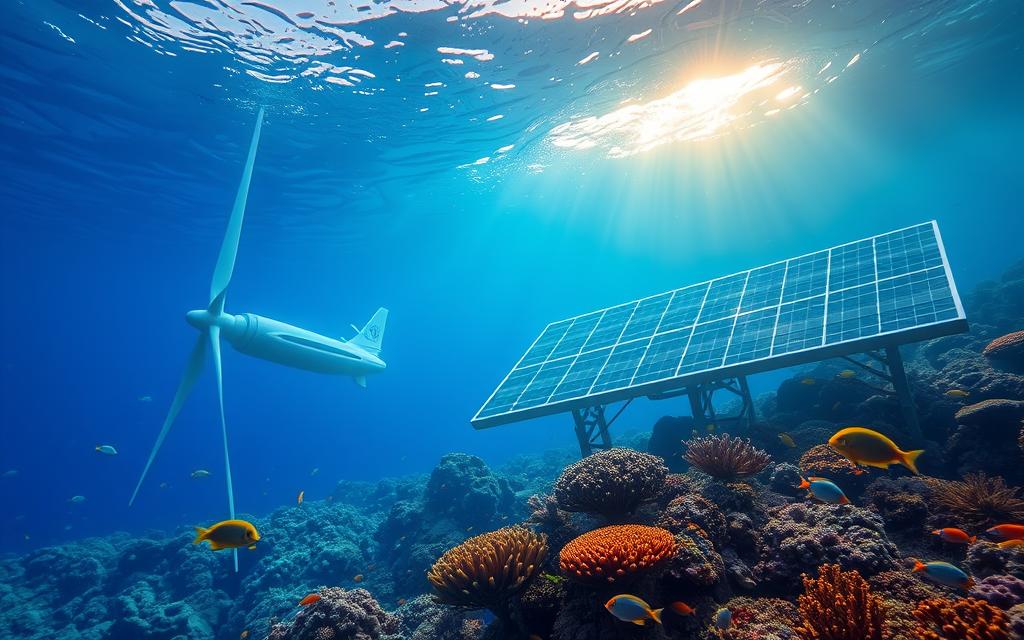
Wave Energy Converters
Wave energy converters are also vital for marine energy. They turn ocean waves into electricity. With so much ocean, wave energy could be a big part of our renewable energy mix.
As these technologies improve, they will become more important in our shift to sustainable energy. They help us use the ocean’s power to our advantage.
Underwater Communication Systems
Underwater communication is key in ocean tech, letting divers and devices talk to each other and the surface. Underwater systems have changed how we explore and interact with the sea. They help with marine life studies and climate change research.
The growth of ocean networking has helped us learn more about marine life. Scientists use marine sensors to gather data on the sea’s physics, chemistry, and biology. This data is vital for checking the sea’s health and helping conservation.
Some main uses of underwater communication systems are:
- Recreational diving
- Underwater photography and videography
- Search and rescue operations
- Commercial diving
- Military operations
These systems use underwater communication tech, like sound signals, to send data. Ocean networking and marine sensors let us watch the sea in real-time. This helps us manage marine resources better.
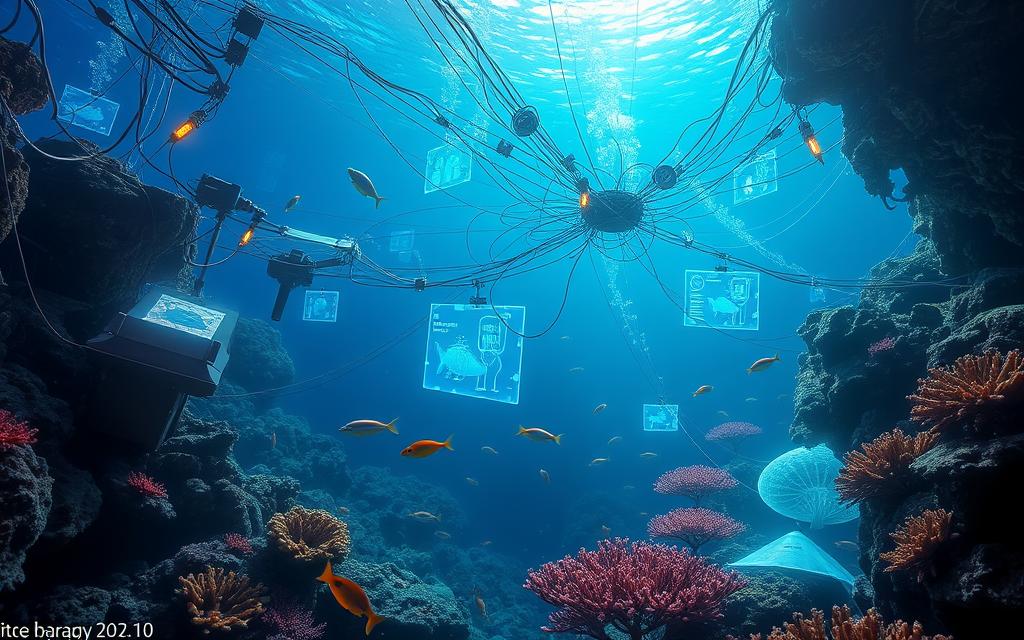
As we delve deeper into our oceans, the need for underwater communication systems will grow. Investing in these techs opens doors for science, conservation, and sustainable growth.
| Application | Description |
|---|---|
| Marine biodiversity surveys | Using underwater communication systems to monitor and track marine life |
| Climate change research | Deploying marine sensors to collect data on ocean temperature, chemistry, and currents |
| Search and rescue operations | Utilizing underwater communication systems to locate and recover missing persons or vessels |
Marine Conservation and Research Technologies
Marine conservation and research technologies are key to protecting our oceans. Coral reef monitoring systems help track the health of reefs. This lets researchers find areas that need help.
Marine life tracking devices also play a big role. They track the movements and behaviors of sea creatures. This gives us insights into where they live and how they move.
Arthur Gleason, a Pew marine fellow, introduced underwater landscape mosaics for coral reef conservation in 2020. This new method has changed how we monitor Caribbean coral reefs. Juan Patino-Martinez, a 2023 Pew marine fellow, uses satellite telemetry to track loggerhead sea turtles in Cape Verde.
Technologies like aquadrones and biomimetic undersea robots help clean our oceans. WasteShark aquadrones, made by the Dutch company RanMarine, can pick up to 500 kilograms of trash daily. These tools help us tackle the big challenges facing marine life.
Some important stats show why marine conservation is vital:
- Almost 80% of marine litter is plastic, with 14 million tons entering the ocean yearly.
- Ship strikes hurt almost 80 whales on the West Coast of the USA each year.
New technologies offer hope for solving these problems. They help us understand and protect marine ecosystems. Using these technologies is essential for the future of our oceans.
| Technology | Application | Impact |
|---|---|---|
| Coral reef monitoring systems | Tracking coral reef health | Identifying areas for conservation |
| Marine life tracking devices | Monitoring marine species | Providing insights into habitats and migration patterns |
| Aquadrones | Ocean clean-up | Collecting marine litter |
Commercial Applications of Ocean Technology
Commercial ocean technology is changing many industries. This includes offshore exploration, marine mining, and aquaculture. New tech like autonomous underwater vehicles and sensors makes these operations better and greener. For example, offshore exploration is now more accurate, helping companies find and get resources without harming the environment.
Aquaculture is also seeing big changes. With more people wanting seafood, new fish farming systems are being created. NOAA scientists found a “good” bacteria that keeps oysters healthy. This could make fish farming better for the planet and more sustainable.
Key Commercial Applications
- Offshore oil and gas exploration: using advanced tech to find and get resources well
- Marine mining operations: using underwater vehicles to get minerals and metals
- Aquaculture systems: using new tech and ideas like probiotics for better fish farming
These uses of ocean tech are boosting the economy and helping the planet. As more money goes into ocean tech, we’ll see even more cool ideas. These will change how we use our ocean resources for the better.
| Industry | Application of Commercial Ocean Technology |
|---|---|
| Offshore Exploration | Autonomous underwater vehicles and sensors for efficient resource location and extraction |
| Marine Mining | Autonomous underwater vehicles for mineral and metal extraction |
| Aquaculture | Probiotics and advanced technologies for sustainable and healthy fish farming practices |
Conclusion: The Future of Ocean Technology and Maritime Innovation
The Monterey Bay Aquarium Research Institute (MBARI) is working hard to protect our oceans. They aim to inspire people to care about marine life. They do this through internships, workshops, and social media.
MBARI wants to share exciting stories about the ocean. They hope to get more people involved in ocean exploration and conservation.
The future of ocean technology and maritime innovation looks bright. New technologies like AUVs and renewable energy could make shipping better. They could also help reduce harm to the environment.
As the maritime industry grows, it will use new tech like blockchain and AI. This could lead to a future where trade and ocean health go hand in hand.
Innovation and teamwork are key to a sustainable future. MBARI is helping to inspire the next generation of ocean explorers. They are crucial in protecting the ocean’s wonders for future generations.
FAQ
What is the significance of understanding the ocean and its potential to inspire new technologies and conservation efforts?
The ocean is vast and mostly unexplored. Knowing it is key for marine science and engineering progress. It can lead to new tech and conservation, helping the environment and society.
What are the key components that make up modern ocean technology?
Modern ocean tech includes underwater vehicles, sensors, and data platforms. These tools have grown from simple exploration aids to today’s advanced systems. They help us understand the ocean better.
How are revolutionary underwater mapping systems changing our understanding of the ocean floor?
New mapping systems, like LASS, create detailed seafloor maps. They give us deep insights into the ocean’s layout. These tools are vital for marine conservation and finding new species.
What are the different types of deep-sea exploration vehicles and equipment used in ocean technology?
Deep-sea exploration uses various vehicles and tools. These include AUVs, ROVs, and manned submersibles. They’ve helped us learn about the deep sea and made amazing discoveries.
How are ocean monitoring and data collection technologies contributing to our understanding of ocean processes?
Sensors, drones, and other platforms collect ocean data in real-time. This is crucial for studying ocean processes like climate change and fisheries management. It also aids conservation efforts.
What are the innovations in marine renewable energy, and what is their potential for a sustainable future?
Marine renewable energy includes tidal, wave, and offshore wind tech. These innovations could lead to a sustainable energy future. Biomimetics, studying nature’s designs, inspires new solutions in this field.
How are underwater communication systems advancing ocean research and conservation?
Underwater systems, like marine sensor networks, are key for ocean communication and data sharing. They’re vital for ocean research and conservation progress.
What are the technologies used in marine conservation and research, and how are they contributing to our understanding of marine ecosystems?
Technologies like coral reef monitoring and marine life tracking are crucial for conservation and research. They help us discover and protect marine ecosystems.
What are the commercial applications of ocean technology, and what are the opportunities and challenges in this field?
Ocean tech has uses in offshore oil, marine mining, and aquaculture. These industries offer innovation and sustainability chances. Yet, there are challenges in developing and using these technologies commercially.

